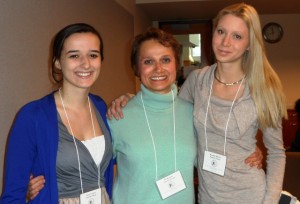Last month, Isabel Connolly ’14 (Westport, Conn.), an art major; Monika Krumova ’13 (Sofia, Bulgaria), a film & media studies major; and Michael Viteritto ’13 (North Caldwell, N.J.), a double major in English and theater, presented their research at the Seventh Undergraduate Conference in Medieval and Early Modern Studies at Moravian College. Nearly 100 students from colleges and universities across the nation participated.
Visit Lafayette’s Russian and East European studies website
Viteritto’s research, “Of Monks and Military Orders: The Search for the Ideal Religious Organization in the Tenth and Eleventh Centuries,” was the result of an independent study with Rachel Goshgarian, assistant professor of history. Due to the nature of his topic and the scarcity of source material, his work was quite difficult.

Isabel Connolly ’14, l-r, Professor Ida Sinkevic, and Monika Krumova ’13 at the Seventh Undergraduate Conference in Medieval and Early Modern Studies at Moravian College
“At several points in my research I found my language skill being tested, because it is near to impossible to find easily accessible translations of primary source Cluniac texts,” he says. “So, I had to do much of the translating from Latin to English myself. It was a difficult process, but in the end it paid off.”
Viteritto plans to pursue medieval studies in graduate school and says the research and conference helped reaffirm his passion for the medieval period.
Connolly and Krumova’s papers were written as a part of the Byzantine Art course taught by Ida Sinkevic, associate professor of art and chair of Russian and East European Studies. The class explores the art and architecture of Asian, Balkan, Eastern European, and Mediterranean countries during the period of Byzantine rule from 343-1453.
“Conference presentation is an honor because students’ papers are evaluated by jurors and only the most successful papers are admitted,” says Sinkevic. “Presentations also serve as a model for active learning as it engages and challenges students far beyond the requirements of the curriculum.”
Connolly’s paper was titled “The Patron’s Commitment to Christianity: The Via Latina Catacomb.”
“This topic provided me with insight into the beliefs of the Roman people during the fourth and fifth centuries,” she says. “The research sparked a new interest in my major and provided me with a new focus.”
Krumova’s paper, “The Impact of Hagia Sophia on Imperial Mosques in Istanbul,” focused on the church Hagia Sophia in Constantinople, present-day Istanbul, and its architectural impact on Imperial mosques after the Ottomans conquered Constantinople in 1453.
“By researching the architectural elements of Hagia Sophia individually, I was able to understand the extent to which the Byzantine Empire influenced Islamic art and architecture,” she says. “This shows how much contrasting cultures and historical times have in common and have interacted with each other.”

1 Comment
It would have been nice to see a picture of every student that went!
Comments are closed.